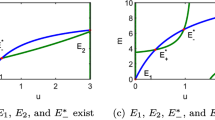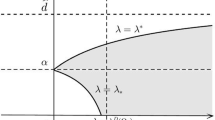Abstract
In the framework of population dynamics, we start from the logistic equation describing the evolution of one species with limited food supply. A split device allows us to consider the population as two sub-populations x and y evolving analogously. The dynamical system has a one-parameter family of equilibria which is structurally unstable. Then small perturbations of the system (describing functional or ethological differentiations between the sub-species) lead in general to a new system involving a fast and a slow dynamics with a finite number of equilibria. In simple situations where the differentiation is clearly either an advantage or an inconvenience for one of the subspecies, the stable equilibrium amounts to extinction of the disadvantaged subspecies (elementary Darwinism). Oppositely more complex differentiations (involving both advantages and inconveniences) often lead to stable equilibria with well-defined non zero proportions of the sub-populations (preservation of the biodiversity). Other examples are concerned with symbiosis-like differentiations, leading to preservation, whereas the opposite case (mutual nuisances) has an unstable equilibrium and lead to extinction of one or the other subspecies according to the initial conditions. The case of a scission into three subspecies is more rich in consequences. In certain cases, predator-prey relations lead to auto-organization phenomena with stable diversity-preserving diversity. Cases of instability are also possible, leading to orbits tending towards a poly-cycle.This implies some kind of pseudo-extinction: this amounts to “pseudo-periodic-like” orbits with “pseudo-periods” larger and larger, tending to infinity; each pseudo-period contains parts where one of the sub-populations practically vanish. Other non-linear perturbations lead to stable orbits.












Similar content being viewed by others
References
Eigen M, Schuster P (1979) The hypercycle: a principle of natural self-organization. Springer, Berlin
Françoise J-P (2005) Oscillations en biologie collection mathématiques and applications, vol 46. Springer, Berlin
Hofbauer J, Sigmund K (1998) Evolutionary games and population dynamics. Cambridge University Press, Cambridge
Hofbauer J, Mallet-Paret J, Smith HL (1991) Stable periodic solutions for the hypercycle systems. J Dyn Differ Equ 3:423–436
Lobry C (2001) Modèles déterministes en Dynamique des Populations Ecole CIMPA Saint Louis du Sénégal
Mallet-Paret J, Smith HL (1990) The Poincaré–Bendixson theorem for monotone cyclic feedback systems. J Dyn Differ Equ 4:367–421
May RM, Leonard W (1975) Nonlinear aspects of competition between three species. SIAM J Appl Math 29:243–252
Schuster P (2011) The mathematics of Darwin’s theory of evolution: 1859 and 150 years later. In: Chalud FACC, Rodrigues JF (eds) The mathematics of Darwin’s legacy mathematics and biosciences in interaction. Springer, Berlin, pp 27–66
Author information
Authors and Affiliations
Corresponding author
Rights and permissions
About this article
Cite this article
Sanchez-Palencia, E., Françoise, JP. Structural Instability and Emergence of the Biodiversity. Acta Biotheor 61, 397–412 (2013). https://doi.org/10.1007/s10441-013-9193-5
Received:
Accepted:
Published:
Issue Date:
DOI: https://doi.org/10.1007/s10441-013-9193-5




